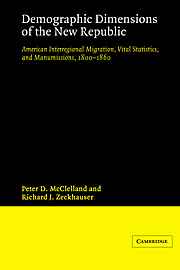 Demographic Dimensions of the New Republic
Demographic Dimensions of the New Republic Book contents
- Frontmatter
- Contents
- List of tables
- Preface
- Map 1 Regions of the United States
- 1 Introduction and summary
- 2 Migration model: closed population
- 3 Migration model: adjustments for international migration
- 4 Interregional migration estimates 1800–60
- 5 White population: birth rates, death rates, and rates of natural increase
- 6 Negro population: birth rates, death rates, rates of natural increase, and manumissions
- 7 Conclusions
- Appendixes
- Notes
- Bibliography
- Index
2 - Migration model: closed population
Published online by Cambridge University Press: 19 September 2009
- Frontmatter
- Contents
- List of tables
- Preface
- Map 1 Regions of the United States
- 1 Introduction and summary
- 2 Migration model: closed population
- 3 Migration model: adjustments for international migration
- 4 Interregional migration estimates 1800–60
- 5 White population: birth rates, death rates, and rates of natural increase
- 6 Negro population: birth rates, death rates, rates of natural increase, and manumissions
- 7 Conclusions
- Appendixes
- Notes
- Bibliography
- Index
Summary
The model
The technique used to estimate net migration is the census survivor method outlined in the United Nations manual on demographic procedures. In summary form, for a closed population this technique requires only population data and a single assumption. The data must be available for each region, by desirable age cohort, at the time of the census. The assumption is that the death rate, by age group, is constant across all regions. Census data can then be used to calculate intercensal survival rates: the percentage of the total population of a given age, or age grouping, that survived to the next census. A survival rate for a particular age group can then be combined with the total population within a region who are within the age group in question to estimate the expected number of survivors at the time of the next census. The difference between the actual number of people enumerated in the next census and the expected number of survivors is the estimate of the net number of migrants in a particular age group who entered the region in question and survived until the next census. (If the net migration number is negative, it records the net number of individuals who would have survived to the next census who left the region.)
The technique is perhaps most easily explained using mathematical notation.
- Type
- Chapter
- Information
- Demographic Dimensions of the New RepublicAmerican Interregional Migration, Vital Statistics and Manumissions 1800-1860, pp. 20 - 29Publisher: Cambridge University PressPrint publication year: 1983
